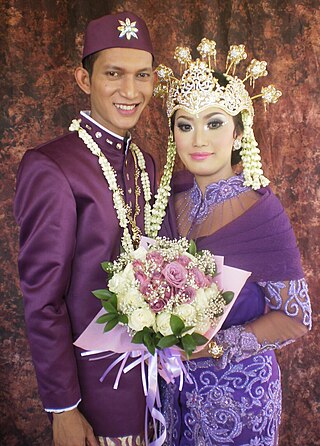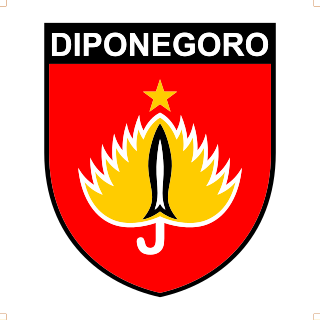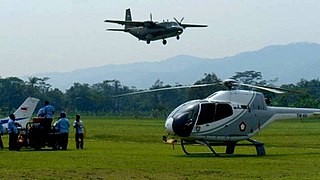Related Research Articles

Sundanese is a Malayo-Polynesian language spoken by the Sundanese. It has approximately 32 million native speakers in the western third of Java; they represent about 15% of Indonesia's total population.

Javanese is a Malayo-Polynesian language spoken by the Javanese people from the central and eastern parts of the island of Java, Indonesia. There are also pockets of Javanese speakers on the northern coast of western Java. It is the native language of more than 68 million people.

Central Java is a province of Indonesia, located in the middle of the island of Java. Its administrative capital is Semarang. It is bordered by West Java in the west, the Indian Ocean and the Special Region of Yogyakarta in the south, East Java in the east, and the Java Sea in the north. It has a total area of 33,750.37 km2, with a population of 36,516,035 at the 2020 Census making it the third-most populous province in both Java and Indonesia after West Java and East Java. The official population estimate in mid-2023 was 37,608,336 The province also includes a number of offshore islands, including the island of Nusakambangan in the south, and the Karimun Jawa Islands in the Java Sea.

The Tenggerese people are a sub-ethnic group of Javanese in eastern Java who claim to be the descendants of the Majapahit princes. Their population of roughly 100,000 is centered in 30 villages in the isolated Tengger mountains in the Bromo Tengger Semeru National Park in eastern Java.

The Sundanese are an indigenous ethnic group native to the western region of Java island in Indonesia, primarily West Java. They number approximately 42 million and form Indonesia's second most populous ethnic group. They speak the Sundanese language, which is part of the Austronesian languages.

Banyumas Regency is an inland regency in the southwestern part of Central Java province in Indonesia. Its capital is the town of Purwokerto, but that town no longer has a central administration and is split over four of the districts within the Regency, with a combined population of 233,865 as of mid-2023. The Regency covers an area of 1,391.15 km2, and had a population of 1,554,527 at the 2010 Census and 1,776,918 at the 2020 Census; the official estimate of the population as of mid-2023 was 1,828,573.

Tegal is a city in the northwest part of Central Java of Indonesia. It is situated on the north coast of the province of Central Java, about 175 km (109 mi) from Semarang, the capital of the province. It had a population of 239,599 at the 2010 Census and 273,825 at the 2020 Census; the official estimate as of mid-2023 was 262,781.

The Great Post Road is the name for the historical road that runs across Java that connects Anyer and Panarukan. It was built during the reign of Herman Willem Daendels (1808–1811), governor-general of the Dutch East Indies, using unpaid forced labor that cost thousands of lives.

Indramayu Regency is a regency (kabupaten) of the West Java province of Indonesia. It covers an area of 2,099.42 km2 and had a population of 1,663,737 at the 2010 census and 1,834,434 at the 2020 census; the official estimate as of mid 2023 was 1,894,325. The town of Indramayu is its capital.

The Osing language, locally known as the language of Banyuwangi, is the language of the Osing people of East Java, Indonesia.

KODAM IV/Diponegoro or IV Military Regional Command/Diponegoro is a military area command of the Indonesian Army. It covers the provinces of Central Java and Special Region of Yogyakarta on the island of Java. It is named after the Java War hero Prince Diponegoro. It appears to have been first established in 1950, and inherited the heritage of the former 3rd Diponegoro Division and other Central Java infantry units. Diponegoro Division personnel have been very significant in the history of the Indonesian Army. Among its early officers were Sarwo Edhie Wibowo, who served as battalion and regimental commander in the division from 1945-53. Former commanders of the division include Soeharto, a former president of Indonesia. Divisional personnel, including Lieutenant Colonel Untung Syamsuri, were involved in the 30 September Movement events of 1965. Former president Susilo Bambang Yudhoyono was also member of this KODAM when he took command of KOREM 072/Pamungkas at Yogyakarta during his military tenure.

Bumiayu District is an administrative district (kecamatan) in the Brebes Regency, Central Java, Indonesia. Bumiayu is the centre of community activity in the south of Brebes Regency. It covers 82.09 km2 and had a population of 96,201 at the 2010 Census and 112,680 at the 2020 Census. It formerly included those areas which now form the separate districts of Tonjong, Sirampog, Bantarkawung, Salem, and Paguyangan.

Jenderal Besar Soedirman Airport, also known as JB Soedirman Airport is an airport located in Purbalingga Regency, Central Java, Indonesia.

Banyumasan or Banyumasan Javanese is a collective term for a Javanese subgroup native to the Indonesia's westernmost part of Central Java. At approximately ±9 million people, they are concentrated in Banyumas, Cilacap, Kebumen, Purworejo, Purbalingga, and Banjarnegara regencies. The Banyumasan-Javanese speak Banyumasan dialect of Javanese language, a dialect which is often called "basa ngapak-ngapak".
Tenggerese is a language used by the Tenggerese people in the mountain region of the Bromo Tengger Semeru National Park which includes Pasuruan Regency, Probolinggo Regency, Malang Regency and Lumajang Regency of East Java, Indonesia.
Cirebon Sundanese is a variety of conversation in Sundanese in the ex-Residency of Cirebon and its surroundings, which includes Kuningan, Majalengka, Cirebon, Indramayu and Subang as well as Brebes in Central Java.

Brebes Sundanese is the dialect of Sundanese language used by some people in Brebes Regency, Central Java, especially in the southern and southwestern parts of the region. The area of Brebes Regency is one of the districts in Central Java which borders the West Java region.
The 2023 Liga 3 Central Java is the eighth season of Liga 3 Central Java organized by Asprov PSSI Central Java.
References
- ↑ Abdul Muslim (3 December 2015). "Bahasa Banyumasan Terancam Punah" [Banyumasan Language Threatened with Extinction]. Berita Satu (in Indonesian). Retrieved 25 March 2022.
- ↑ "Bupati Luncurkan Aplikasi Kamus Bahasa Banyumas" [Banyumas Regent Launches Banyumasan Language Dictionary Application]. banyumaskab.go.id (in Indonesian). Archived from the original on 13 January 2020. Retrieved 15 February 2020.